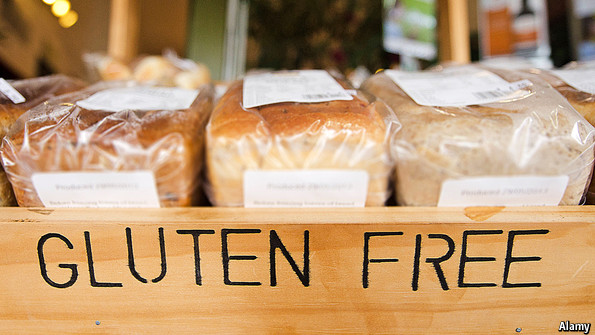The Gluten-Free Fad: SWOT, Differentiating & Market research
by MoekoUrawa
Gluten-free products are popular these days.
This Economist article talks about how the change in the consumer awareness and preference towards gluten-free product has affected the food industry as a whole. Even though only around 1% of the world population is medically diagnosed with coeliac disease, a sizeable proportion of people believe that gluten-free is healthier or think of it as fashionable, and cuts consumption on products containing gluten. In fact, these gluten-free-bandwagon-hoppers are the main consumers that drive the market forward. A marketing research corporation, Mintel estimates that;
“the category [gluten-free range] will produce more than $15 billion in annual sales in 2016.”

SOURCE: http://www.economist.com |More and more consumers are being aware of the health risks associated with foods containing gluten|
Using the SWOT Analysis discussed in class, we can identify how new Opportunities created by the gluten-free food movement can become businesses’ internal Strength.
For instance, manufacturers can transform the Opportunity of increased market demand for gluten-free food into their Strength – ability to charge higher price[1] for profit maximisation and establishment of a “supreme” corporate identity.
Also, I suppose there are Opportunities created for firms to expand their customer base since more consumers are now willing to pay extra for a gluten-free lifestyle. Marketing is everything in the food industry due to the existence of many generic me-too products in the industry, pressuring firms find the “differentiator”. Firms’ effective marketing techniques scare consumers into thinking wheat are toxic and anything with a “gluten-free” label is associated with “low calorie” and “healthy lifestyle”. A lot of the firms choose to attach the label on the packagings of unrelated products that have always been gluten-free (ie. popcorns, nuts) to emphasise the Points of Difference that distinguishes them from other non-gluten-free competitor’s. Such firms will automatically gain a new market segment on their Business Model Canvas.
My Thoughts:
As a pro-choice vegetarian, I am able to relate to the views of non-coeliac consumers to some extent. However, I strongly feel that this gluten-free craze is no more than a social trend and will eventually burst, like it has for the “Fully Raw” fad in the late 2000s. I believe while the marketing of transient food can encourage the fad to ascent rapidly, social media backlashes against living gluten-free diet[2] are equally a powerful force that reshape the perception and interest of non-coeliac consumers, forcing the fad to experience a decline. In another words, more consumers will inevitably realise that eating gluten-free cakes is not the answer to losing weight!!! Such kind of situation would fall under the category of Threat in the SWOT Analysis.
Likewise, this article subtly asserts the importance of market research and knowledge about the consumer when entering new trends. Although “vegetarians outnumber those who avoid gluten”[3], gluten-free is more “trendy” of the two (market is more active/responsive). Without the qualitative and quantitative investigation of the current market, firms will fail to identify the ever-changing market trends, and even risk producing products that no one wants (product-oriented). Equally, market research helps firms to forecast the future demand patterns. In this case, I strongly feel that producing only gluten-free food is neither socially nor economically sustainable strategy as “gluten-free” label is unlikely to survive the Threats from the media.
End Note
[1]Gluten-free customers are valuable, ringing up roughly $100 in sales with their average grocery basket compared with $33 for the overall average basket
[2] Gluten-free diet can lack vitamins, minerals, and fibre; essential nutrients for a balanced diet.
[3] The food industry is finding that there is no longer much money to be made in making meat-free products. Sales of alternatives to meat have flattened in America in real terms since 2008; in Britain they have plunged by a third
Work Cited
“Against the Grain.” The Economist. The Economist Newspaper, 25 Oct. 2014. Web. 26 Oct. 2014.